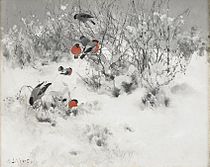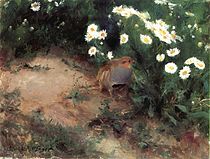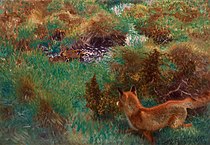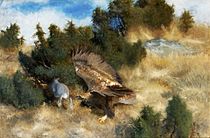Bruno Liljefors
Bruno Liljefors | |
|---|---|
Royal Swedish Academy of Arts, Stockholm | |
| Known for | Painting |
| Signature | |
 | |
Bruno Andreas Liljefors (Swedish pronunciation:
Biography




Liljefors was born in
In 1887, he married Anna Olivia Olofsson (1864–1947). The marriage ended with a divorce in 1895 at which time he married his first wife's younger sister Signe Adolfina Helena Olofsson (1871–1944). He was a resident of Uppsala, until the summer of 1894 when he sought out the
During the last years of the nineteenth century, a brooding element entered his work, perhaps the result of turmoil in his private life. He was often short of money and in 1925, he suffered a facial
Work
Liljefors is held in high esteem by painters of wildlife and is acknowledged as an influence by, for example, American wildlife artist Michael Coleman. All his life Liljefors was a hunter, and he often painted predator-prey action, the hunts engaged between fox and hare, sea eagle and eider, and goshawk and black grouse serving as prime examples.[1] However, he never exaggerated the ferocity of the predator or the pathos of the prey, and his pictures are devoid of sentimentality.[8]
The darker quality in his paintings gradually began to attract interest, and he had paintings exhibited at the Paris Salon. The influence of the
Collections of his art are on display at the Nationalmuseum, Gothenburg Museum of Art, Thiel Gallery and Uppsala University.[5] His work was also part of the painting event in the art competition at the 1932 Summer Olympics.[9]
Style
He amassed a collection of animals to act as his living models. Ernst Malmberg recalled:
The animals seemed to have an instinctive trust and actual attraction to him. There in his animal enclosure, we saw his inevitable power over its many residents—foxes, badgers, hares, squirrels, weasels, an eagle, eagle owl, hawk, capercaillie and black game.[1]
The greatness of Liljefors lay in his ability to show animals in their environment.[1] Sometimes he achieved this through hunting and observation of the living animal, and sometimes he used dead animals; for example, his Hawk and Black Game, painted in the winter of 1883–84, was based on dead specimens, but he also used his memory of the flocks of black grouse in the meadows around a cottage he once lived in at Ehrentuna, near Uppsala. He wrote:
The hawk model—a young one—I killed myself. Everything was painted out of doors as was usually done in those days. It was a great deal of work trying to position the dead hawk and the grouse among the bushes that I bent in such a way as to make it seem lively, although the whole thing was in actuality a still life.[1]
- Winter landscapes
-
Winter landscape with bullfinches, 1891
-
Winter landscape at dawn, 1900
-
Winter hare, 1908
-
Winter hare, undated
Assessment
Such practices have sometimes led to criticism of Liljefors' work; Lars Jonsson has noted a "heraldisation" of the drama in Golden Eagle Chasing a Hare, 1904, which causes a departure from pure naturalism, and he deduces from the position of the eagle's wing feathers that it would have been gliding rather than turning in reaction to the hare as painted.[1]
Nevertheless, Liljefors was a pioneer at a time when wildlife art was still emerging from its association with scientific depiction and taxidermy. He also set a standard of identification with the landscape that substantially influenced the development of wildlife art in the twentieth century.
Paintings
-
Foxes, 1885
-
Swifts, 1886
-
A fox family, 1886
-
Sleeping Jeppe, 1886
-
Weasel with Chaffinch, 1888
-
Partridge with daisies, 1890
-
Sea eagle's nest, 1907
-
Fox stalking wild ducks, 1913
-
Swans, 1920
-
Bean geeseshedding, 1921
-
Eagle hunting hare, 1924
-
White-tailed eagles hunting, 1924
-
Eiders at sunrise, 1928
References
- ^ ISBN 1-873403-55-0, pp. 31–40.
- ^ a b "Liljefors, Bruno Andreas". Svenskt biografiskt handlexikon. 1906. Retrieved March 1, 2019.
- ^ "No Greater Naturalist: Paintings of Bruno Liljefors". The Electric Lighting Company. March 3, 2018. Retrieved March 1, 2019.
- ^ Brita Linde. "Bruno A Liljefors". Svenskt biografiskt lexikon. Retrieved March 1, 2019.
- ^ a b "Bruno Liljefors". Nationalmuseum. Retrieved March 1, 2019.
- ^ "Ruben Mattias Liljefors". Nordisk familjebok. Retrieved March 1, 2019.
- ^ "Liljefors, Bruno Anders". Vem är det - Svensk biografisk handbok. 1925. Retrieved March 1, 2019.
- ^ "Michael Coleman". Coleman Studios. Retrieved March 1, 2019.
- ^ "Bruno Liljefors". Olympedia. Retrieved 2 August 2020.
Other sources
- Allan Ellenius (1996) Bruno Liljefors: Naturen som livsrum (Bonnier Alba) ISBN 978-9134517943
- Tor Harald Hedberg (2010) Bruno Liljefors (Nabu Press) ISBN 978-1149622391
- Martha Hill (1987) Bruno Liljefors the Peerless Eye (Doubleday) ISBN 978-0385243612

















